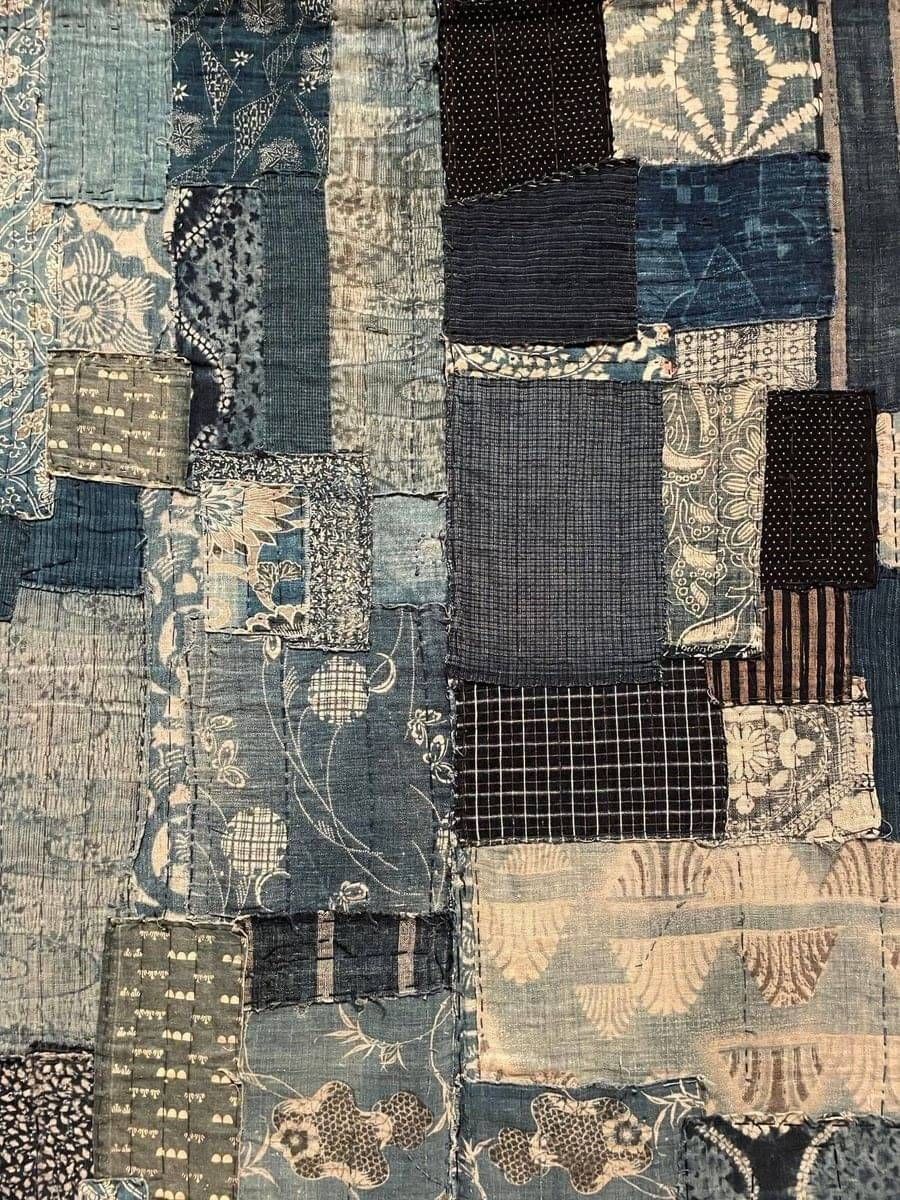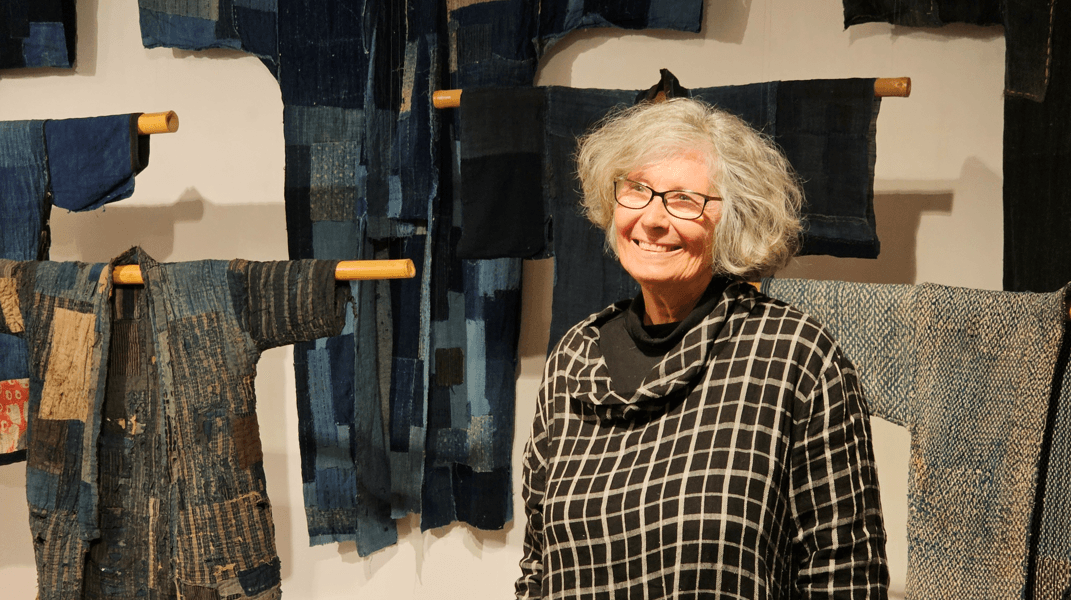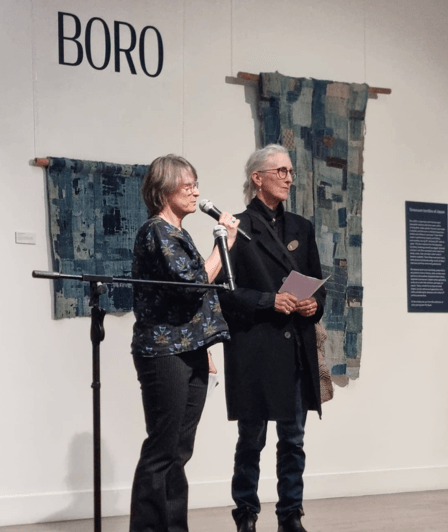BORO Morrinsville -
Timeworn Textiles of Japan
Curator/collector Pip Steel24 September - 7 December
An exhibition of extraordinary quality and subject We are thrilled to present Boro Morrinsville - Timeworn Textiles of Japan, a unique and visually compelling exhibition that showcases the rich history, beauty, reverence, and ingenuity of Japanese textile traditions. This show is likely the most extensive exhibition of genuine Boro artifacts displayed in New Zealand to date.
Curated by Pip Steel of Carterton, the private collector behind this extraordinary body of work, the exhibition features an incredible array of hand-stitched and layered textiles.

A highly decorative indigo-dyed boro cotton two-panelled piece with sashiko stitching. A remnant of a larger complete Japanese futon cover,

Pip Steel pictured after her recent visit and talk, Boro Morrinsville
“Boro” means “rags” or “tattered cloth” in Japanese, these works speak deeply to themes of resilience, sustainability and creativity in the face of hardship. With their rich textures, patchwork forms, and subtle colour palettes and patterning, the textiles cross boundaries between historical artifact and contemporary art.
Included in the exhibition are three powerful, large scale contemporary pieces of 'boro inspired' artwork by talented Tamaki Makaurau artist Susie Pascoe. Susie’s stunning works sit beautifully with Boro - Timeworn Textiles of Japan pieces in an emotionally moving sense as well as visually and by methodology, they gently move the show from traditional to modern perfectly.
All Boro Morrinsville is exhibited in our gorgeous main Art House Trust gallery.

Morrinsville Gallery Curator Liz Borrows (no pun intended) with Contemporary Fibre Artist Susie Pascoe at the opening ceremony for the show.
Don’t miss this opportunity to visit and experience these powerful works—crafted with reverence, rooted in history and resonant with meaning. Please join our newsletter via this link so you can keep up-to-date with announcements about workshops, talks and events!
We hope that if you enjoyed the chance to see the exhibition that you might consider a donation to the gallery, it is/was a paid for exhibition so we will happily accept we cash or Eft pos donations plus have added our bank details here, should you prefer this method. Thank you kindly for your generosity, in advance.
All donations big or small are gratefully accepted
Morrinsville Art Gallery Charitable Trust 02-0368-0042073-000
Visit Us at Morrinsville Gallery!
Weekdays (Tuesday to Friday): 10:00 AM – 4:00 PM
Weekends (Saturday & Sunday): 11:00 AM – 3:00 PM
Closed on Mondays
Special hours for group visits can be arranged by emailing director@morrinsvillegallery.org.nz
The Morrinsville Art Gallery Charitable Trust extends its deepest gratitude to the many individuals and organisations who have helped bring this exhibition to life. From Pip Steel’s creative vision to the generous support of Susie Pascoe, Elizabeth Borrows, The Arts House Trust, Matamata-Piako District Council via the Pride of Place Grant, our dedicated volunteers (who collectively we estimate contributed around 180 hours of prep and install time), Fundraising committee, Tis The Season (Matangi), The Ribbon Rose (Auckland), Red Star Signs (signage), Morrinsville College, Morrinsville Museum, WSA and Everybody’s Op Shop (furnishing loans and gifts)—this has been a true community effort. Their contributions have made this exhibition not only possible, but truly meaningful.
A Very Special Thank You
To the incredible team at the Matamata-Piako District Council’s Pride of Place fund—thank you for your critical and generous support toward the installation and first four weeks of our exhibition.
Your contribution made it possible for us to host this important and meaningful show, and we are deeply grateful for your belief in our vision and in the cultural life of our community.
Sashiko Stitching Workshops at the Morrinsville Gallery with artist and teacher Pip Steel inspired by her exhibition Boro - Timeworn Textiles of Japan.
Saturday 6th December from 2.30 pm – 5 pm Sunday. Limited numbers: $55 per person. Booking essential, please contact the Morrinsville Gallery at info@morrinsvillegallery.org.nz
A Special to thank you to The Matamata Piako District Council Pride of Place fund and The Arts House Trust who critically and generously supported the costs around the install and first 4 weeks of the Boro Morrinsville exhibition. Without this assistance we may not have been able to host this important show.










